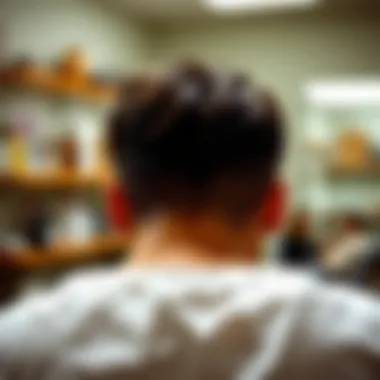Mastering Self-Haircutting Techniques for a Flawless Look


Intro
Cutting your own hair might seem like venturing into the wild unknown, but it can actually be a true skill to master. Self-haircutting enables you to take control of your style and express yourself on your own terms. First, let’s take a step back and understand why this topic matters. As lifestyles shift and personal expression becomes more prominent, many men are seeking ways to look sharp without relying on salon visits that can quickly take a toll on one’s wallet.
This article unpacks not just the practicalities of self-haircutting, but also the mindset behind it—a blend of confidence, creativity, and necessity. Whether you are dealing with longer locks or just a simple trim, the information here will help you navigate the often-tricky terrain of self-cutting with grace.
Trendy Haircut Trends
In the ever-evolving realm of men’s fashion, haircuts can make as big of a statement as one's choice of clothing. From the classic fades to the audacious undercuts, staying current can elevate your entire appearance. Here’s a look at some of the latest haircut trends that are catching on this season:
- Textured Quiff: This hairstyle, characterized by volume and movement on top, allows for creativity while remaining classic. Achieving this look at home might require some practice, but the results are stunning.
- Disconnected Undercut: A bold choice, this style emphasizes stark contrast between the top and sides, perfect for those wanting to stand out.
- Curly Top: For those with natural curls, let them flow free! Styling curly locks requires minimal effort, yet presents a casual yet chic vibe.
To execute these styles, consider using the right tools, like professional-grade scissors, clippers, and combs. A good pair of hair clippers can be your best ally, especially for fade and undercut styles.
Expert Advice on Maintenance
Once you've gone through the trouble of cutting your own hair—whether it was a hit or miss—mouth-watering maintenance is key to ensure it continues to look fresh. Here are some maintenance tips:
- Regularly schedule trims, ideally every 4-6 weeks, to keep the shape intact.
- Invest in quality hair products that suit your hair type, such as gels for hold or leave-in conditioners for moisture.
- Consider nurturing your hair and scalp with natural oils; coconut or argan oil can work wonders.
"Good hair days lead to good mood days." That’s the kind of mentality to adopt while caring for your locks!
Trendy Haircut Inspiration
To stay inspired, look no further than celebrities and influencers who set the standard. A few haircut inspirations include:
- Timothée Chalamet: The textured look with a curly top is both effortless and striking, proving that embracing one’s natural hair can turn heads.
- David Beckham: He often switches between styles, from trendy undercuts to classic side parts. His looks can provide a plethora of options to experiment with.
- Zac Efron: Known for his constantly evolving hairstyles, Zac has rocked everything from long layers to cropped styles, showcasing how versatility can be charming.
Use these references, but remember—individuality is where true style lies. Adjust any cut to suit your face shape and personal flair!
By combining awareness of current trends with practical cutting techniques, you’ll not only save money but also find a rewarding hobby that boosts your confidence in your style abilities. Let's move ahead to further explore the journey of self-haircutting!
Foreword to Self-Haircutting
Self-haircutting is an empowering skill that many people might overlook in their hair care regimen. It's a blending of precision, art, and practicality. There’s something downright satisfying about not just leaving your haircut to chance but taking the reins to craft your desired look. Understanding the nuances of cutting one's hair can save time, money, and even boost one's self-esteem as one becomes more fashionable and self-reliant.
Understanding the Motivation
Why choose to cut your own hair rather than booking an appointment at a salon? For many, the motivation lies in the quest for autonomy. Some individuals grow tired of waiting weeks or paying hefty sums for a trim that can often feel rushed or not quite right. The drive is also often about experimenting with personal style. With trends changing rapidly, why not grab a pair of scissors and try out new styles at home?
Moreover, self-haircutting provides a unique sense of accomplishment. When you take the time to learn the techniques, it transforms what could be a daunting task into a rewarding experience. Plus, it's often quite liberating; no one understands your hair as you do, so there’s a level of intuition that makes this skill incredibly personal.
Common Misconceptions
As exciting as self-haircutting can be, there are several misconceptions that might deter individuals from trying it out. First, one might think it's reserved only for those with hairdressing experience or that it requires a DVD of step-by-step lessons. However, anyone can master the basics with a bit of patience and practice.
Another common misunderstanding is that self-haircutting means compromising on quality. With properly chosen tools and techniques, it’s possible to achieve salon-quality results at home. However, one also needs to acknowledge that it’s not about cutting corners, but rather about learning to navigate one's locks with care and precision.
Preparing for Your Haircut
Preparing for a self-haircut isn’t just a formal routine; it lays the groundwork for the entire process. A well-prepared individual is often set up for success, while poor preparation can lead to unexpected mishaps, like uneven layers or worse yet, a hairstyle that doesn’t align with your vision. Here, we will delve into the essence of preparation, looking closely at the tools you’ll need and the optimal environment for your haircutting endeavors.
Essential Tools and Supplies
Before you even think about picking up a pair of scissors, you need to gather your tools. Working with the right equipment can make all the difference. Here’s a breakdown of the must-have items:
- Hair Cutting Scissors: Invest in a good pair of scissors designed specifically for cutting hair. Regular scissors can cause more split ends.
- Clippers: For those who prefer shorter styles, clippers can provide a precision cut and often come with various guard lengths.
- Comb: A fine-tooth comb helps in parting and sectioning the hair.
- Mirror: Ideally, you should use two mirrors—a handheld and a wall mirror—so you can see the back of your head clearly.
- Cape or Towel: Drape a cape or towel around your shoulders to catch hair clippings and keep your clothes clean.
- Spray Bottle: Slightly damp hair can be easier to manage. A spray bottle with water helps tame your locks.
- Clip-Hair Clips: These are great for sectioning your hair, allowing you to focus on one area at a time.
Having these items within arms reach means that you won't need to scramble halfway through your cut, which is key for maintaining focus and minimizing mistakes.
Choosing the Right Environment
The environment you choose for your self-haircut is almost as essential as the tools themselves. It’s crucial to select a space where you can work comfortably and without distractions. Here’s what to consider:
- Lighting: Good lighting is non-negotiable. Natural light is ideal, but if that’s not possible, set yourself up in a well-lit room to avoid missing sections or cutting mistakes.
- Space: Ensure you have enough room to move and that your tools are organized. A cluttered space can lead to accidents and a chaotic cutting experience.
- Surface: Use a flat surface like a bathroom counter or a table where tools won’t easily tumble over. Make sure it’s clean and equipped to handle hair clippings.
Creating a serene and organized atmosphere will allow you to focus on the task at hand. Just as a painter needs a blank canvas, you need the right setting to execute your hair masterpiece.


"Preparation is the key to success. Without the right tools and environment, your haircutting experience can quickly turn from an art to a headache."
In summary, setting yourself up for a successful self-haircut hinges on preparation. Gather those essential tools and carve out a suitable environment. You’ll be surprised by how much of a difference it makes when you combine the right gear with a calm space.
Identifying Hair Types
Understanding the various hair types is a cornerstone in mastering self-haircutting. Each type has its unique characteristics, and recognizing these traits can significantly influence the techniques used during the cutting process.
- Benefits of Identifying Hair Types
- Tailored Techniques: Familiarity with hair types allows you to tailor cutting techniques that suit your specific hair needs, ensuring a more satisfying result.
- Accurate Expectations: Knowing your hair type helps in setting realistic expectations about how a haircut will look post-trim.
- Product Selection: Understanding hair type aids in selecting the right tools and products that will not only protect the hair during cutting but also enhance its appearance afterwards.
Identifying your hair type is not merely an academic exercise; it serves as a practical guide in making informed decisions while you wield those scissors.
Straight Hair
Straight hair is characterized by its smooth texture and lack of curls or waves. It often reflects light well and can appear sleek when cut properly. For individuals with straight hair,
- Cutting Techniques: Basic trims can often be achieved with blunt cuts, while layering may need to be practiced to avoid the "flat" look.
- Considerations: Straight hair tends to show mistakes more clearly, so precision is vital during cutting.
Curly Hair
Curly hair comes with its own charm but also presents unique challenges. Each curl behaves differently, which makes cutting a bit more complex.
- Cutting Techniques: A method called the "curl by curl" technique may be effective. This approach allows for more control and the ability to see how each curl falls after the cut.
- Considerations: Curly hair can shrink after being cut, so keep that in mind when determining lengths. It's crucial to leave a little extra hair to account for this tendency.
Wavy Hair
Wavy hair inhabits the realm between straight and curly, offering flexibility in styling. Its structure allows for various cutting styles.
- Cutting Techniques: When working with wavy hair, a combination of layering and blunt cuts can be particularly effective. This allows the waves to bounce without appearing too heavy.
- Considerations: Different areas of wavy hair may curl more or less, so be prepared to adapt your technique as needed during the cut.
Thick vs. Thin Hair
Hair thickness impacts not only styling but also cutting techniques.
- Thick Hair:
- Thin Hair:
- Cutting Techniques: Thinning shears can be a useful tool for thick hair, helping to reduce bulk while maintaining length. Be cautious, as over-thinning can lead to frizz.
- Considerations: Regular trims are essential to avoid split ends, and cutting technique must be adapted based on the density of the hair.
- Cutting Techniques: With thin hair, avoid heavy layering, as it can lead to a limp look. A blunt cut at the ends can create the illusion of fullness.
- Considerations: Always cut with caution to avoid removing too much hair which might result in an undesirable appearance.
Identifying your hair type is not just a theory; it’s a valuable aspect of self-haircutting that directly impacts the quality of your haircut. Understanding how each type behaves will guide your cutting approach, offering you the skill and confidence to achieve your desired look.
Techniques for Cutting Hair
Understanding the various techniques for cutting hair is crucial for anyone venturing into the world of self-haircutting. Mastery of these techniques doesn't just lead to better aesthetics; it plays a significant role in building confidence and fostering independence in managing one's appearance. Each technique caters to different styles and hair types, allowing for personalized outcomes that flatter individual features.
The Basic Trim
The basic trim is the bread and butter of self-haircutting. It's about removing split ends and maintaining a clean shape without altering the overall style too drastically. This technique is especially vital for those who want to keep their hair looking healthy without necessarily committing to a full haircut. For the best results:
- Utilize sharp scissors to ensure a clean cut.
- Gather the hair into sections to create uniformity.
- Cut about a quarter inch at a time, assessing the length as you go.
Taking your time is essential; rushing can lead to uneven results. This basic technique serves as the foundation upon which more complex styles are built, hence its importance cannot be overstated.
Layering Techniques
Layering techniques add depth and dimension to the hair. This is particularly appealing for those with thick or heavy locks that might otherwise look flat. By creating layers, you can enhance movement and texture, allowing for a more stylish appearance.
There are several methods to achieve layered looks:
- Vertical Cutting: Start at the base and cut vertically upward into the sections. This method provides soft layers.
- Point Cutting: Snip the ends of each section at an angle. This technique gives a more textured appearance.
- Overdirection: Pull sections of hair forward before cutting, making the layers blend smoothly.
Layering requires practice. It’s often best to start with longer layers if you're uncertain, and adjust accordingly.
Creating Bangs


Bangs can dramatically change one’s appearance, framing the face and often fetching a youthful look. However, cutting bangs at home can be a bit tricky and requires careful consideration. Straying even slightly can lead to an undesirable outcome. Here’s how to go about it:
- Determine the desired length before you cut. Always opt for longer bangs initially; they can always be shortened later.
- Use a comb to section the hair and secure the rest to avoid cutting too much.
- Cut in small increments; start from the center and work your way out to ensure evenness.
With bangs, the phrase less is more is particularly relevant. You can always go back later for a touch-up to achieve the look you want.
Tapering and Fades
Tapering and fades can elevate a self-haircut to the next level, adding a polished finish that appears professionally done. Tapering refers to gradually reducing the hair length from the top down to the sides and back. Fades, on the other hand, create a seamless transition between short and long hair.
To attempt tapering:
- Use clippers, starting at a longer guard length near the top.
- Gradually switch guards as you move down the head, decreasing length progressively.
- Blend the transitions using a comb.
For fades, the same principle applies, but the transition is often sharper. Consider practicing on less noticeable areas if you're still honing your skills.
Step-by-Step Haircut Guide
The act of cutting your own hair may seem daunting, yet it holds the potential to be both liberating and rewarding. This guide focuses on providing a step-by-step process that will assist you in executing a successful self-haircut. A well-structured approach not only boosts confidence but also helps mitigate anxiety associated with the unpredictable nature of haircuts. Moreover, understanding these steps allows you to tailor the process to your specific hair type and desired outcome. Equip yourself with the necessary knowledge to navigate this journey with ease, and you’ll be better prepared for any styling choice you wish to make.
Preparation and Sectioning Hair
Before you start snipping away, preparation is key. Ensure your hair is clean and dry, as this provides a clearer picture of what you’re working with. Here’s a neat little checklist to guide you through:
- Wash and dry your hair: Using a mild shampoo is advisable to avoid product buildup that can mislead you during your cut.
- Gather your tools: You'll need sharp hair scissors, a comb, clips, and a mirror—your toolkit for the day.
- Sectioning: Use clips to divide your hair into manageable sections. Typically, hair is best cut in four quadrants, as it allows your focus to narrow. This keeps everything orderly and prevents any mishaps. Each section can be laid flat while you tackle your cut, which also helps in achieving uniformity.
Executing the Cut
Cutting is the crux of the process. Approaching this step with a steady hand and patience will yield the best results. Here are some pointers:
- Start small: Begin by trimming a small amount; you can always cut more, but you can’t put it back once you’ve taken it off. Carefully hold your section of hair between your fingers, lifting it to the desired length and snipping away.
- Follow the natural shape: Respect the natural flow and angle of your hair when cutting. This involves being attentive to how your hair falls and what your intended style is meant to achieve. For instance, when trimming bangs, hold the hair at a slight angle to give it a softer look.
Remember that it’s better to make several gentle cuts rather than one big chop. This detail-oriented strategy greatly enhances precision, ultimately delivering a neater finish.
Final Touches
This is where everything ties together. After you’ve made your cuts, take a moment to review your handiwork:
- Blend your layers: Use texturizing scissors or the tip of your regular scissors to soften the edges of the cut. This blending technique smooths out your layers or any stark lines you may have noticed during the first pass.
- Style it up: Add your favorite product to enhance the texture or volume of your hair. Whether it’s pomade for a sleek finish or a mousse for added body, the right product can completely transform your look.
- Check it in different lights: Utilize natural light to examine your haircut from various angles. Grab your hand mirror to check the back. This often-overlooked step can reveal any areas that might need a little extra work.
"The final appearance of the haircut often lies in the details; focus on minor adjustments to ensure perfection."
Mastering these steps will elevate your haircutting skills dramatically and gives you a sense of achievement. Further tips and discussions can be found on Reddit Haircutting Community or consult articles on self-haircutting techniques from Wikipedia. These resources offer a wealth of shared experiences and insights to refine your self-haircutting journey.
Post-Haircut Maintenance
Post-haircut maintenance is a vital part of the self-haircutting process that is often overlooked. Just as an artist meticulously brushes the final strokes on their masterpiece, a self-haircut requires a dedicated approach afterwards to ensure it remains fresh and stylish. Neglecting this stage can transform a well-executed cut into a tangled mess within days, ruining the effort you put into it.
Cleaning and Storing Tools
Keeping your tools clean and well-organized is essential. Dirty scissors or clippers can lead to unsatisfactory results and can even damage your hair. Here are some key steps for maintaining your tools:
- Wipe down the blades: Use a soft cloth dampened with rubbing alcohol to clean the scissors regularly. This helps remove any hair residue.
- Oil your clippers: If you use clippers for a clean cut, apply a couple of drops of clipper oil after each session. It keeps the blades lubricated and functioning smoothly.
- Store properly: After cleaning, store your tools in a dry place, away from moisture. A zippered pouch or a dedicated drawer works well.
You want your tools to last longer and perform at their best every time you decide to take the plunge.
Caring for Your Hair Post-Cut
Once you're done with cutting, the journey is not over yet. Your hair may need some extra care to look its best. Here are a few considerations:
- Hydrate your hair: After a fresh cut, applying a good leave-in conditioner helps keep it moisturized. This is especially important for those with thicker or curly textures.
- Avoid harsh shampoos: Immediately after a cut, steer clear of shampoos with sulfates or strong fragrances. Opt for gentle, sulfate-free variants that nurture.
- Protect from styling damage: Consider using a heat protectant before applying any styling tools. It shields your hair from potential damage.
These steps ensure that your hair stays healthy and maintains that fresh-from-the-barber shine.
Styling Perfectly After the Cut
Styling after a haircut can make all the difference in flaunting your new 'do. Here’s how you can achieve a polished, stylish finish:


- Experiment with products: Whether it’s pomade, wax, or gel, using the right styling product can help achieve the desired look. Apply small amounts gradually to prevent a heavy, greasy appearance.
- Don’t rush the process: Take your time to style. Use a comb to achieve the desired parting or texture. A casual, hurried approach often leads to less-than-ideal results.
- Follow the hair’s natural direction: Work with your hair's natural texture and growth patterns. This can make styling easier and ultimately more flattering.
The best style is often the one that feels the most natural.
By focusing on post-haircut maintenance, not only do you extend the lifespan of your fresh cut, but you also demonstrate a level of sophistication in managing your own image. A little attention post-cut can make a lasting impression.
Troubleshooting Common Issues
When you decide to cut your own hair, it can feel empowering to take control of your style. However, unforeseen issues may arise, and troubleshooting is an essential part of the self-haircutting journey. Understanding these common problems can help you minimize frustration and improve your technique over time. This section delves into the art of troubleshooting in self-haircutting, emphasizing that even the best stylists make mistakes, and there is always a path to remedy them.
Dealing with Mistakes
- Breathe and Evaluate: Rather than rushing to rectify a mistake, take a step back to determine what has actually gone awry. Sometimes what feels terrible is not as bad as it looks.
- Speak to a Friend: A fresh pair of eyes can be beneficial. If a friend or family member can visit, ask for their opinion. They might provide insight that could guide your next steps.
- Strategic Cuts: If an error was made, try to make further cuts that complement or balance it out rather than fixate on the mistake. This may involve revisiting lengths or utilizing layering techniques to blend the cut.
"Mistakes in haircuts are just opportunities for creativity.
Correcting Uneven Cuts
Uneven cuts, while common, can be daunting. After you've revised the situation and confirmed it's truly uneven, it's time to address it without transforming it into a bigger problem. Addressing unevenness is about honing in on precision and ensuring the final look appears intentional.
- Identify Problem Areas: Stand in front of good lighting and carefully inspect your hair. Check for straggly ends or varying lengths.
- Use a Comb: A fine-tooth comb can help you gather your hair evenly and section it off properly. This will help isolate areas that need correction.
- Cut Gradually: Sometimes less is more. When you’re correcting uneven cuts, it's better to take off small amounts rather than attempting to fix it all at once. Start with tiny snips and continuously check your progress.
- Balance with Layers: If you find that certain areas are particularly short, integrate layering techniques where sections of hair can flow together better. This can disguise unevenness effectively.
- Check the Mirror: Constantly monitor your cuts using the mirror. Tilt your head slightly to see the cut from different angles, ensuring a comprehensive view.
Using these pointers allows for a fluid transition from a mishap to a manageable hairstyle. Always remember, the goal isn't just to fix, but to create a style that you feel confident wearing. For additional insights into common hair styling mistakes or more tips, consider visiting Wikipedia or checking forums on Reddit.
Emotional Considerations of Self-Haircutting
Self-haircutting is not just about wielding scissors and a comb; it's an emotional journey that intertwines creativity and vulnerability. Engaging in this practice can significantly transform one’s perception of self-image and boost confidence. The act of cutting one’s own hair can feel empowering, providing a sense of control over one’s appearance at a time when so much about life feels unpredictable. As fashion-conscious men navigate their personal styles, understanding the emotional aspects of self-haircutting becomes crucial.
A self-haircut allows for an exploration of individual identity, offering the chance to express personal style without the constraints often found in salons. Achieving a look that genuinely aligns with one’s personality creates a deeper connection to self-image and, in turn, enhances emotional well-being. Moreover, having the ability to make such decisions independently fosters resilience and self-reliance, qualities that pervade various aspects of life.
Building Confidence
Embarking on the journey of self-haircutting can serve as a powerful catalyst for building confidence. Many individuals experience a surge of self-esteem when they master new skills, and hair-cutting is no exception. The first leap often feels daunting, but once you’ve successfully executed a cut, it’s almost like unlocking a new level of self-assuredness. That warm glow of satisfaction when a snip yields a look that pleases the eye can’t be understated.
Confidence goes hand in hand with practice. Just like any skill, the more you cut your hair, the better you become. It’s important to embrace mistakes as learning opportunities rather than setbacks. Remember, every haircut is a chance to learn about technique and your preferences. Over time, honing your craft can lead to an impressive repertoire of styles that reflect who you are.
- Practice Makes Perfect: Each attempt adds to your experience.
- Document Your Progress: Taking photos before and after can help you see the improvement.
- Positive Affirmation: Celebrate small successes to help reinforce a confident mindset.
To ensure a thriving self-haircut practice, consistency is key. As you become more skilled, you might find yourself experimenting with styles you never thought possible, thereby further enriching your sense of self and style.
Handling Hair-Related Stress
In a world where appearance can feel like a judgmental lens through which one is viewed, it’s no surprise that hair-related stress is common. The fear of a bad haircut can loom large, influencing decisions and self-perception. It’s vital to acknowledge these feelings as valid, yet also understand how to manage them.
One way to tackle hair-related stress is through preparation. Before even contemplating a cut, have a clear plan. Know what styles resonate with you and gather inspiration from magazines or online platforms. The more prepared you are, the less anxious you will feel about making a mistake.
"Preparation is the key to success; it can turn the tide in stressful moments."
Moreover, perspective plays a significant role. Recognize that hair grows back. A temporary mistake does not define your overall look or value. Engaging in self-reflection post-haircut can also provide insight. Ask yourself what you learned from the process, and how you can apply those lessons moving forward.
- Breathe: Take deep breaths to calm nerves before cutting.
- Set Realistic Expectations: Understand that not every haircut will be flawless.
- Use Affirmations: Remind yourself that hair is just a small aspect of who you are.
By embracing these techniques, hair-related stress can diminish, allowing for a more enjoyable self-haircutting experience. As with any art form, learning to love the process will lead to greater satisfaction and less stress over time.
Closure and Final Thoughts
In the realm of self-haircutting, the journey extends far beyond just the physical act of trimming one’s hair. This practice embodies a profound sense of empowerment, fostering personal growth, and instilling a deeper connection with oneself. As explored throughout the article, the art of self-haircutting offers a multifaceted approach to self-care. Not only does it save time and money, but it also encourages a greater understanding of one’s unique hair type and styling preferences.
The ability to wield scissors, whether they be a simple pair of hair shears or a more sophisticated tool, transforms the way individuals perceive their own appearance. This act goes hand-in-hand with the confidence boost that comes from mastering a new skill. Feeling good in your own skin or hair is not merely an aesthetic pursuit; it’s a vital component of mental well-being. Self-haircutting can thus become a symbolic gesture of independence in a world that often seems out of control.
Moreover, as emphasized, it allows an opportunity to experiment, fostering creativity while providing a hands-on approach to self-expression. The importance of this autonomy speaks volumes, especially in today’s society where the choices made about our appearance can greatly impact our self-esteem.
"Cutting your own hair is not just about style; it’s a declaration of self-reliance and innovation."
The Empowerment of Self-Care
Self-care emerges as a cornerstone in the dialogue surrounding self-haircutting. The empowerment gained from engaging in such a personal ritual profoundly contributes to one’s overall well-being. In the act of trimming and styling one’s hair, individuals uncover a form of autonomy that is often lacking in other facets of life. This simple yet significant act serves to reinforce one’s identity, enhancing both self-image and self-esteem.
Consider how taking the time to manage one’s hair reflects the broader commitment to self and personal health. Each snip can resonate with the idea of self-love, representing care undertaken in the most intimate sense. Furthermore, the rewards from mastering self-haircutting techniques mark a significant leap in personal growth.
Encouragement to Experiment
Exploration in self-haircutting is not only encouraged but is essential for honing one’s skills. Each haircut offers a unique canvas for creativity. Whether it’s trying a different length, altering a style, or simply refining basic techniques, this endeavor serves as an open invitation for experimentation.
Those who embrace a trial-and-error mindset will find that mistakes are not failures but rather stepping stones toward mastery. It can be beneficial to view every cut as an opportunity to learn and grow. Additionally, sharing experiences in online communities such as Reddit or specialized forums may provide valuable insights and inspiration. All these aspects coalesce into a rich tapestry of personal development, making the journey of self-haircutting an exciting adventure worth embarking upon.















